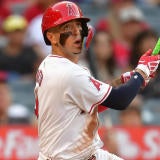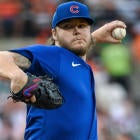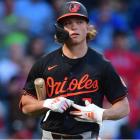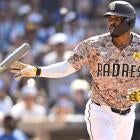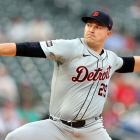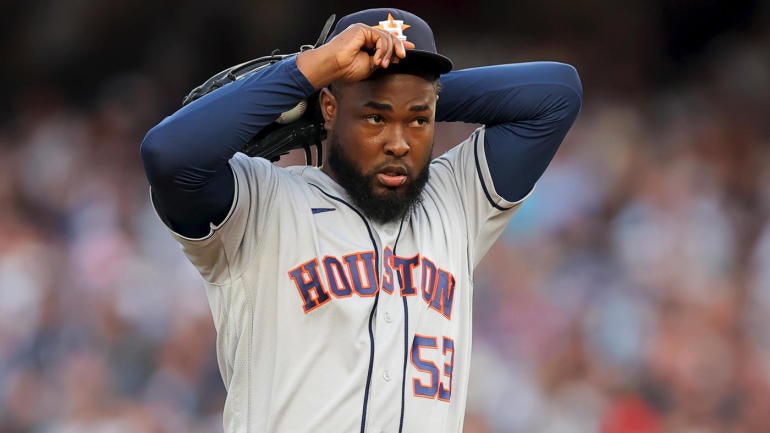
Starting pitcher has put us through the wringer the past few years.
First was the strange dichotomy of the juiced ball era, when most of the league's pitchers were getting their faces caved in but a small contingent capitalized on a "spin revolution" to deliver numbers as dominant as the game has ever seen. The method of attack for Fantasy Baseball was pretty clear in those days: get in early or feel the pain.
Then came the great moderating of 2022, when changes to the way the ball was manufactured and stored led to a resurgent middle class at starting pitcher, making those early-round aces no longer the only path to success. And just like that, the traditional approach of favoring hitters early and grabbing upside arms on the cheap was restored.
Or so it seemed at this time a year ago, when we were still so trusting and innocent, oblivious to the monstrosity swelling up behind us, its sights set on consuming all that was decent and fair. By the time 2023 had ended, it had swallowed up every pitcher it could grab hold of and left its markings on most every one that it couldn't, such that there were no longer any aces nor any middle class. There was only The Glob.
The Glob is what happens when a perfect storm of rule changes leads to more baserunners (via the so-called shift ban) and more base activity (via the so-called pickoff limits), all while insisting on a faster tempo (via the so-called pitch clock) even as things begin to spiral. And so spiral they did, all the way out of control. Blowup starts became common, creating volatility throughout the pitching ranks and morphing that resurgent middle class into a collection of random number generators, each one's ERA being only as good as his last start.
Just look at this breakdown for Head-to-Head points scoring (minimum 100 innings, rounded to the nearest full point), and you'll see what exactly I mean by The Glob. Aces have been taken down a peg, and the middle tiers have all melded together into an indistinguishable mass:
| | 2023 | 2022 | 2021 | 2019 | 2018 |
19+ PPG | 1 | 4 | 3 | 5 | 8 |
17-18 | 1 | 17 | 8 | 10 | 4 |
11-16 | 70 | 56 | 53 | 44 | 45 |
What a mess it created, and that mess is still on our hands. We are all inside The Glob, my friends, our movements stilted, our vision hazy. It's hard to know what steps to take when you can't trust a pitcher's numbers at any point in time. After all, the next blowup is impending. The Glob will have its say.
But what's this? A light within the darkness? A beacon through the storm? Could it be strikeouts that lead us out of this globby nightmare?
That's my theory, anyway -- or what I'm calling "Globology." If a pitcher's ERA and WHIP is less within his control now and more susceptible to the capriciousness of a runaway inning, then prioritizing ERA and WHIP in drafts is ultimately self-defeating. You're just guessing, at least to a higher degree than before, and there's too much draft capital at stake for that.
You know what stat has always been within a pitcher's control? Strikeouts. Pitchers who miss bats continued to miss bats last year, even with all the rule changes, so if you invest in those pitchers, you can trust -- barring injury, of course -- that you'll place high in that category. It's not a guess; it's a given.
And as it turns out, pitchers who miss bats are less vulnerable to the shift ban and the increased batting average on balls in play that came with it. Those pitchers are, after all, less reliant on balls in play for their outs. So by selling out for strikeouts, you may wind up with a better ERA and WHIP just by happenstance because bat-missers naturally have more upside in those areas.
I'm not exactly breaking new ground there. The benefits of missing bats have been well established since the sabermetrics revolution of the early 2000s, which is how a stat like FIP came to be in our vernacular. But since the arrival of Statcast in 2015, the analytical emphasis has shifted to contact quality. That made some sense at a time when runs were generated primarily by home runs, as has been true for most of the Statcast era, but we're in a different time now -- one in which runs are scored in other ways. And as such, it's time to take that old sabermetrics wisdom and double down on it.
So now you have the theory. What about the praxis? Time for a quick Q and A!
For what formats does 'Globology' apply?
Good question. When I speak of "Globology," I'm speaking mostly for leagues that use 5x5 categories scoring, with a particular emphasis on Rotisserie. What makes The Glob so scary is the volatility it brings to ERA and WHIP, two ratio stats that are only scored in categories leagues. Points leagues deal exclusively in totals, and if a pitcher lasts enough innings, the hits, walks and even runs he allows are less devastating overall. A start that yields a 6.00 ERA and 1.50 WHIP can still be productive for points leagues, but it's doing significant damage to two categories in traditional 5x5 play. And if it's a true blowup start that yields something like an 18.00 ERA and 3.00 WHIP, that's going to undo weeks of progress in a Rotisserie league.
Which is why I say "Globology" applies extra for Rotisserie play. If you get a blowup start in a Head-to-Head league, even if it's a Head-to-Head categories league, you can wash your hands of it once the week is over. But in a Rotisserie league, it stays with you forever.
How should it be implemented?
As with most strategic concepts, it's less an exact procedure than a set of guidelines.
First, let's establish the parameters. There are something like 30 pitchers outside The Glob and 50 pitchers inside The Glob. I say "something like" because we could debate the fringes, as always, but that's not nearly as important right now as how you approach the two groups.
Ideally, I want four pitchers outside The Glob, ones that can lay a sturdy foundation that won't be so easily upended by the random number generators within The Glob. That doesn't mean I'm paying up for the very best the position has to offer -- remember, the high-end starting pitchers aren't as high-end anymore -- but there comes a point fairly early in drafts when my emphasis switches to pitching.
Generally speaking, it happens in Round 4. The first three rounds are full of MVP-caliber bats that stand out more from their earlyish-mid-round counterparts than is true for the pitchers drafted in that same range. Once those bats are gone, the hitter pool flattens considerably, giving you a few rounds to focus on pitching before The Glob sets in. And yes, strikeouts should be the focus even at that point. Realistically, not every pitcher you draft will have massive strikeout upside, particularly if you held off on taking your ace until Round 4, but you'll notice in the table below that most every pitcher outside The Glob is at least decent for strikeouts.
But why four of these pitchers? Well, the 30 will be distributed in some way between the 10 or 12 teams in your league. Having four ensures you a larger-than-normal share heading into The Glob. It also protects against the the possibility of a bust within those four, which is a greater possibility if you're waiting until Round 4 to take your first.
The math changes a bit in deeper formats, such as the 15-team Rotisserie leagues that are so popular within the industry. Because the pre-Glob pitchers are stretched between more teams, the scarcity is greater and the cost goes up. Getting four of the top 30 isn't as realistic, then, which makes drafting a starting pitcher in the first three rounds more palatable.
Which pitchers are outside The Glob?
It's a matter of debate, to be sure, and I'm more confident in some being outside The Glob than others. I've divided this group into two subgroups to illustrate that point, and if you wish to eliminate any from the right-side column (particularly the further down you go), you won't get too much grief from me.
Firmly outside The Glob | Likely outside The Glob |
| |
*presently injured
Which pitchers are inside The Glob?
I've also divided this group into two subgroups, those with hope of escaping The Glob's grasp and those who are likely stuck there for good. I'm gauging this mostly by how I perceive each pitcher's upside for 2024, which is tied largely (but not completely) to his strikeout potential.
The Glob, but with hope | The Glob, but likely stuck |
Note that there are other pitchers worth drafting beyond this rendering of The Glob, including some with genuine sleeper appeal, but they either hardly pitched in 2023 (Emmet Sheehan and Erick Fedde, to name a couple) or have yet to demonstrate the minimal level of competence required to be part of The Glob.


